Digital Poster
Molecular Imaging
ISMRM & ISMRT Annual Meeting & Exhibition • 10-15 May 2025 • Honolulu, Hawai'i

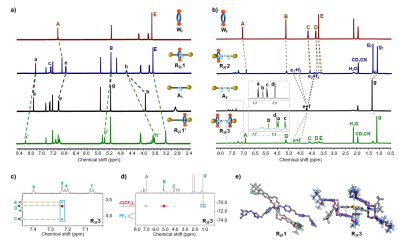 |
Computer Number: 33
3057. Probing
the molecular conformations and dynamics of rotaxanes using 19F
NMR/MRI
Y. Li, Z-X Jiang
Innovation Academy for Precision Measurement Science and Technology, Chinese Academy of Sciences, Wuhan, China
Impact: This study established 19F
NMR/MRI as a powerful tool for probing the molecular
conformations and dynamics of rotaxanes, offering valuable
insights for designing next-generation molecular devices
with enhanced functionality and precise control over
molecular motion.
|
|
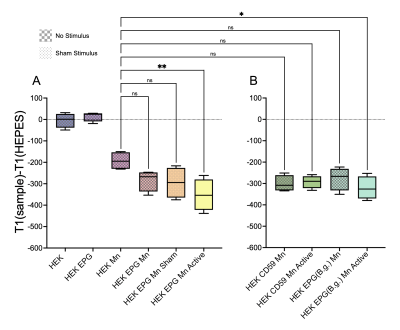 |
Computer Number: 34
3058. MEMRI
as a tool for studying biomagnetism of the electromagnetic
perceptive gene (EPG) protein.
B. Ricker, N. Dayan, A. Gilad
Michigan State University, East Lansing, United States
Impact: These results strongly indicate the potential of
manganese-enhanced MRI (MEMRI) to significantly accelerate
the development of magnetogenetics as a transformative tool
for neuromodulation. MEMRI can facilitate magnetogenetics
toward clinical translation for neural manipulation, thereby
enhancing options for treating neurological disorders.
|
|
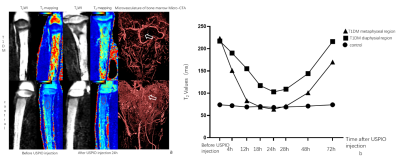 |
Computer Number: 35
3059. Evaluation
of impairment of type H vessels in alloxan-induced diabetic
rabbits using USPIO contrast-enhanced MRI
H. Lei, W. Liu, K. Wang, Y. Zha
Renmin Hospital of Wuhan University, Wuhan, China
Impact: USPIO-enhanced MRI could serve a safe and
convenient to long-term track and observe the impairment of
type H vessels in in vivo T1DM
rabbit under the treatment to diabetic osteopathy through
regulation of microangiogenesis.
|
|
 |
Computer Number: 36
3060. Cascade-activated
CEST nanoplatforms for guided tumor pyroptosis
J. Deng, X. Zhao, Z. Wang
Shanghai General Hospital, Shanghai Jiao Tong University School of Medicine, Shanghai, China
Impact: We developed a smart CEST nanoplatform for
non-invasive visualization of the pyroptosis process,
providing a new strategy for precision tumor therapy. The
nanoprobe was shown to be useful for 3T MR and is expected
to be used in the clinic.
|
|
 |
Computer Number: 37
3061. Translation
of Hyperpolarized [13C,15N2]Urea MRI for Novel Human Brain
Perfusion Studies
Y. Kim, H-Y Chen, T. Nickles, I. Shkliar, D. Dang, J.
Slater, C. Wang, J. Gordon, C. Tan, C. Suszczynski, S.
Maddali, A. Gaunt, R. Chen, J. Villanueva-Meyer, D. Xu, P.
Larson, J. Kurhanewicz, R. Bok, S. Chang, D. Vigneron
University of California, San Francisco, San Francisco, United States
Impact: First-in-human brain MRI studies with
single-agent hyperpolarized [13C,15N2]urea
effectively visualized brain vasculature, including arterial
and venous circulation. This study lays the groundwork for
clinical translation, opening possibilities for perfusion
imaging in neurological and systemic conditions.
|
|
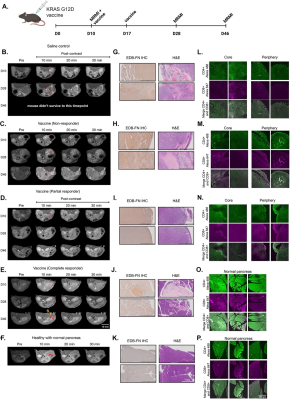 |
Computer Number: 38
3062. Molecular
MR Imaging for Immunosurveillance and Therapeutic Monitoring of
Pancreatic Cancer during Neoantigen Vaccine Therapy
V. Laney, E. Hampson, W. Zhao, I. Hwang, J. Winter, L. Wang,
Z-R Lu
Case Western Reserve University, Cleveland, United States
Impact: By using MR molecular imaging in preclinical
PDAC models we can better evaluate novel therapeutic agents
and provide more accurate and accessible precision care
tools for response prediction.
|
|
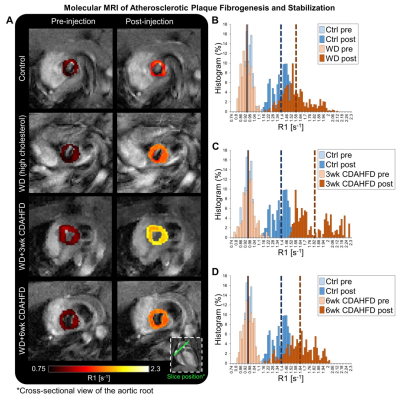 |
Computer Number: 39
3063. Molecular
MRI reveals atherosclerotic plaque fibrogenesis and
stabilization in ApoE-/- mice with steatotic liver disease
B. Moon, Y-C Chen, I. Zhou, Y. Ning, E. Akam-Baxter, M. Le
Fur, H. Ma, J. Weigand-Whittier, N. Rotile, P.
Pantazopoulos, M. Tyros, C. Zhang, C. Farrar, J. Roberts Jr,
Y. Iwamoto, D. Rohde, D. Sosnovik, K. Corey, M. Nahrendorf,
P. Caravan
Cardiovascular Research Center, Massachusetts General Hospital and Harvard Medical School, Boston, United States
Impact:
An innovative fibrogenesis-targeted molecular MR probe revealed that reducing cholesterol resulted in atherosclerotic plaque stabilization even in a high-risk metabolic milieu of steatotic liver disease. |
|
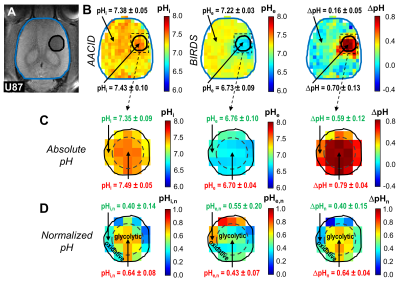 |
Computer Number: 40
3064. Transmembrane
pH imaging distinguishes glycolytic and oxidative phenotypes in
gliomas
D. Coman, S. Mishra, S. Kurdi, J. Santana, F. Hyder
Yale University, New Haven, United States
Impact: Transmembrane pH gradient imaging can be used to
distinguish between glycolytic and oxidative tumor
phenotypes in glioblastoma. This technique could help design
more efficient therapies, where targeting both phenotypes
might be more effective than individually targeting each
phenotype.
|
|
 |
Computer Number: 41
3065. Nanoparticles
Amplify Tumor Targeting via In Vivo Coagulation Cascade for 19F
MRI of Ultrasmall Pulmonary Metastases
R. Wang, D. Chen, S. Chen, X. Zhou
State Key Laboratory of Magnetic Resonance and Atomic and Molecular Physics, Innovation Academy for Precision Measurement Science and Technology, Chinese Academy of Sciences, Wuhan, China
Impact: This platform provides a significant step
forward in precise tumor imaging, opening avenues for
improved diagnostic accuracy and timely intervention in
metastatic lung cancer.
|
|
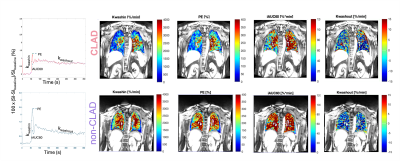 |
Computer Number: 42
3066. DCE-MRI
enables quantitative assessment of microvascular differences in
chronic lung allograft rejection post-lung transplantation
A. Susnjar, M. Hill Pierre-Louis, M. Allison, A. Akinniyi,
P. Caravan, I. Zhou, S. Montesi
Athinoula A. Martinos Center for Biomedical Imaging, Charlestown, United States
Impact: In this study, we report distinct differences in
model-free quantification of contrast kinetics in lung
transplant recipients with CLAD compared to those without,
as assessed by DCE-MRI.
|
|
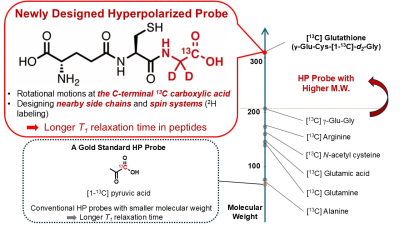 |
Computer Number: 43
3067. Directly
Monitoring the Dynamic In Vivo Metabolisms of Hyperpolarized 13C
Glutathione with Higher M.W. by Breaking Intrinsic 13C T1
Boundaries
K. Yamamoto, Y. Kondo, N. Koyasu, Y. Saito, T. Seki, Y.
Takakusagi, K. Saito, N. Raju, R. Swenson, S. Sando, M.
Krishna
National Institutes of Health, Bethesda, United States
Impact: This principal framework will pave the way for
the future development of hyperpolarized probes, tumor
characterizations, and advanced molecular imaging on
clinically significant metabolic activities further, which
can possibly lead to better prognostics, and earlier
response monitoring in cancer treatment.
|
|
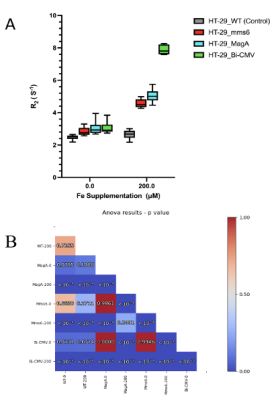 |
Computer Number: 44
3068. Dual
mms6/magA gene expression, improves contrast in cancer cells for
MR imaging
V. Masjedizadeh, J. Langley, W. Darch, J. Morgan, X. Hu
University of California, Riverside, Riverside, United States
Impact: Our demonstration that the dual expression genes
provide enhanced contrast with minimal toxicity to the
cells, indicates dual expression of mms6 and magA is a
suitable MRI reporter gene that can be incorporated for
cancer diagnostics.
|
|
 |
Computer Number: 45
3069. Activated
microglia indicated by PET-[11C]PBR28 binding in multiple
sclerosis correlates with MRI measures of inflammation and
demyelination
I. Vavasour, N. Vafai, E. Shahinfard, P. Beauchemin, C.
Laule, A. Traboulsee, V. Sossi, R. Carruthers, S. Kolind
University of British Columbia, Vancouver, Canada
Impact: Increased inflammation and gliosis may be
driving demyelination, especially in progressive forms of
multiple sclerosis. The ability to measure diffuse
inflammation using PET-[11C]PBR28 and MRI could allow
monitoring of therapies designed to target immune activity
within the whole brain.
|
|
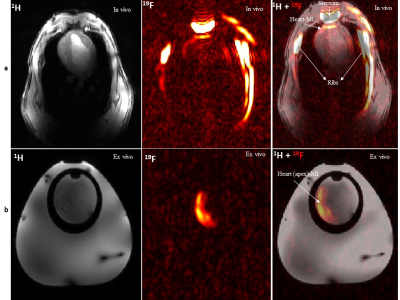 |
Computer Number: 46
3070. Optimizing
of Flourine-19 at 7T MRI in large animal model after Acute
Myocardial infarction.
M. hamid, M. Terekhov, R. Grampp, A. Stadtmüller, M.
Keshtkar, I. Elabyad, S. Dembski, G. Ulm, A. Frey, U.
Hofmann, W. Bauer, L. Schreiber
Chair of Molecular and Cellular Imaging, Comprehensive Heart Failure Center, University Hospital Wuerzburg, Würzburg, Germany
Impact: The present work represents an MRI approach to
test time and intensity of 19F
signal i (ex vivo &in vivo) in large animal after AMI.
|
|
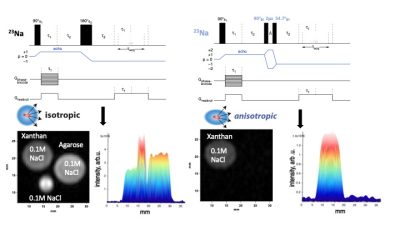 |
Computer Number: 47
3071. Double-Quantum
Filtered 23Na MRS and MRI: Targeted Detection of Ordered Sodium
in Inhomogeneous Fields without 180° Refocusing.
G. Pavlovskaya, S. Wimperis
University of Nottingham, Nottingham, United Kingdom
Impact: The new method is demonstrated both in 23Na
MRS in an inhomogeneous B0 field
and in 23Na
MRI of a three-component phantom. This approach enables the
minimization of SAR effects in sodium imaging at high
magnetic fields.
|
The International Society for Magnetic Resonance in Medicine is accredited by the Accreditation Council for Continuing Medical Education to provide continuing medical education for physicians.